It's bigger, and it just means more: Texas' jump to the SEC shows how much college sports is about to change
AUSTIN, Texas — High above the University of Texas campus, within the school’s iconic clock tower, a party ensues.
This is not any ol’ party. While more than 18,000 orange-clad fans sprawl across the 40 acres below celebrating the school’s entrance into the Southeastern Conference, a much more exclusive gathering unfolds above.
Mere hours before the conference move is official, the people who made the historic decision to leave the Big 12 and join the SEC mill about sipping on beverages and munching on snacks from within the wood-paneled walls of a near-100-year-old library-turned-presidential office.
Jay Hartzell, the university president, cleared out his digs for the soirée, his desk serving as a dessert table and his sun deck as an outdoor bar for those dignitaries receiving invitations. They include more than a dozen Texas head coaches; a handful of board of trustee members and boosters; SEC commissioner Greg Sankey, the person who opened the door when Texas knocked; and the man perhaps most responsible for the conference move: Hartzell’s athletic director, Chris Del Conte.
Soon, fireworks will shoot from the tower, the letters “S-E-C” will illuminate from its windows and, down below, Pitbull — Mr. Worldwide — will serenade the Texas faithful.
“Tonight,” Hartzell told the roaring crowd, “Pitbull is a Longhorn!”
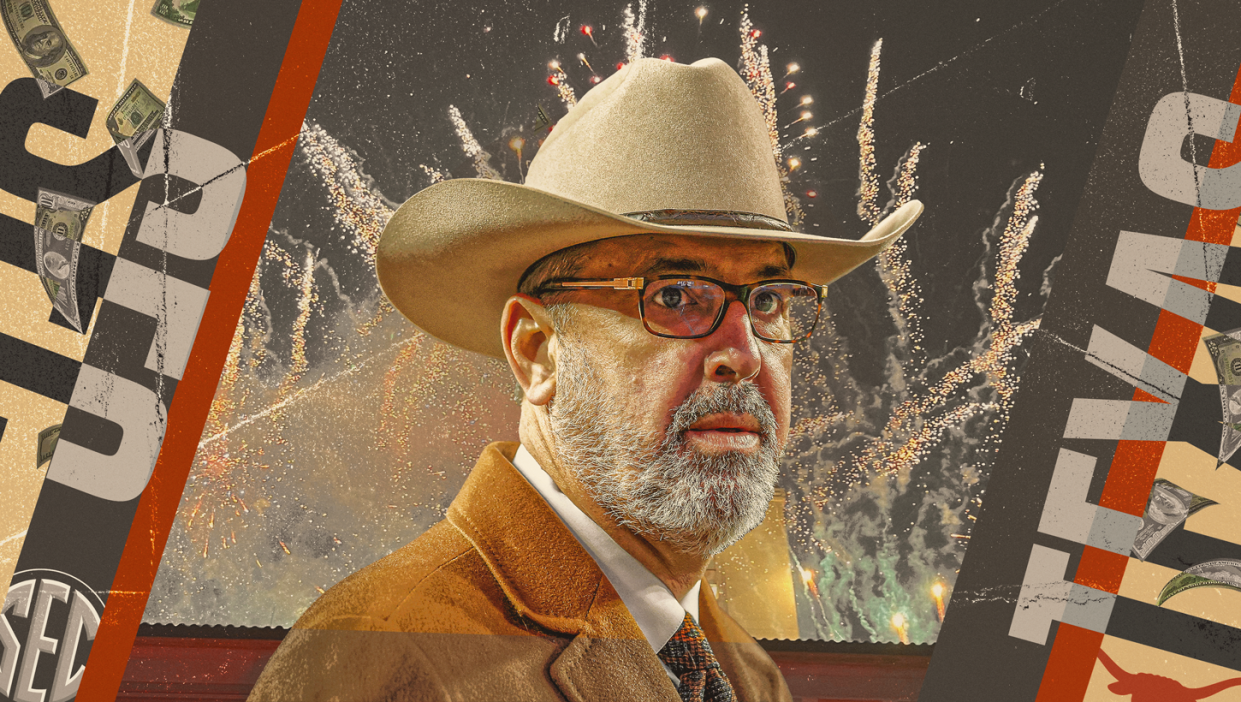
In a way, the party here on the Texas campus represents so much more than one school entering one conference. It is emblematic of a new era in college athletics, where the rich and powerful will hold more influence than ever.
The Longhorns’ move into the SEC, announced July 2021, triggered a tectonic series of events, the first domino in what many describe as the most consequential conference realignment wave in the industry’s history — one that took down an entire power conference, bloated four others and created unmistakeable separation as the biggest brands consolidated into two leagues.
The 2024-25 college athletic year will feature 13 power schools in new conferences, eight more spots in an expanded football playoff, hundreds of millions more in new television dollars and, perhaps most important of all, intense preparation for the leap into professionalism in the fall of 2025 — direct sharing of revenue with athletes.
Handcuffed for years through cost-containment rules upheld by fellow NCAA member schools, the football blue bloods are breaking free of those restraints as amateurism policies collapse and a new governance model is adopted.
It is time, one FCS commissioner told Yahoo Sports, to “let the big dogs eat.” And there is no bigger dog than Texas.
Don’t like it? You don’t have to, says Hartzell, speaking from his concrete clock tower. Complain all you want, deem it as unfair, call it detrimental to the sport. But, it cannot be denied.
“Part of this move was putting our university and athletic programs in the premier league so we’re in a better spot for the way the world is headed,” Hartzell says. “If you look at what’s been happening in college sports, while there is a lot of uncertainty, there is no doubt that you’re seeing the market forces working [so that] the gap between the haves and have-nots is widening. We can not like it, but it’s the way it is.”
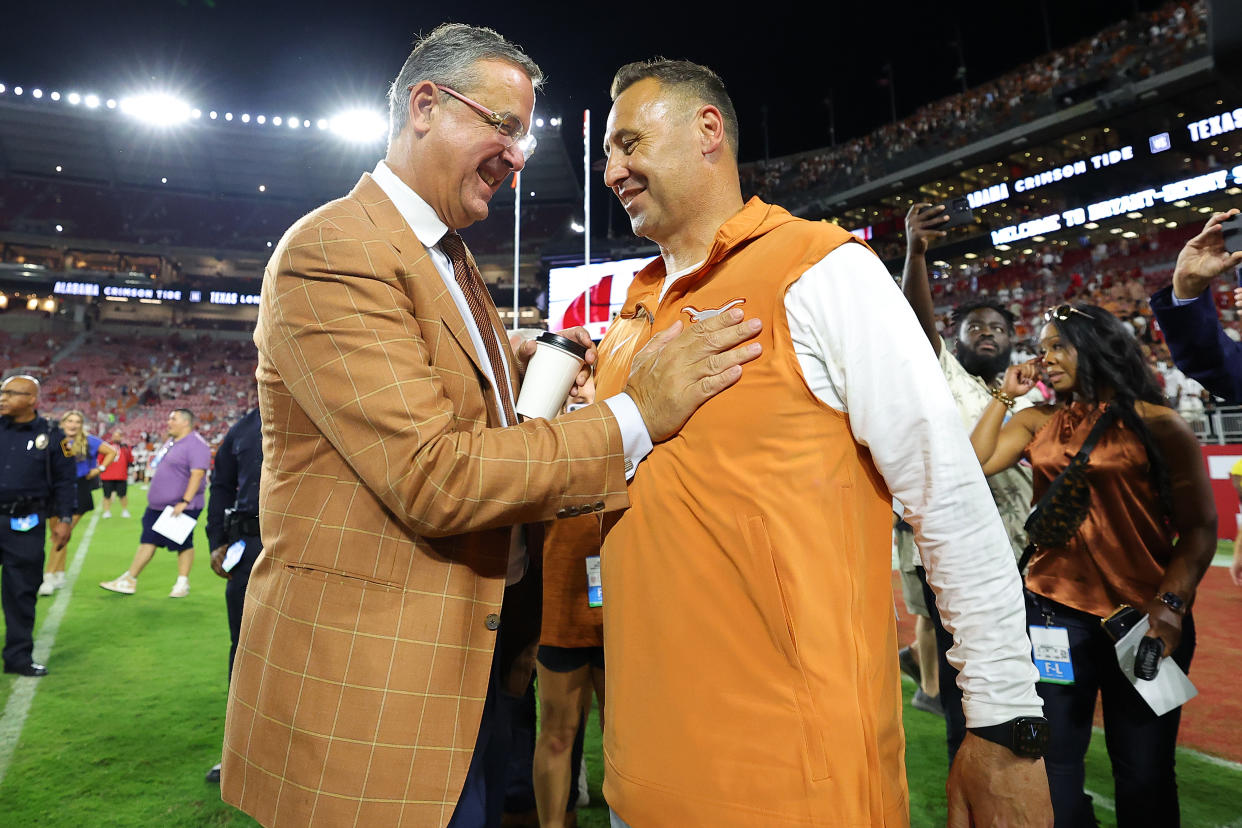
Everything's bigger (and louder) in Texas
Have you ever been to a Texas party? Have you seen the extravagance? Have you witnessed the extra of it all? The entire thing feels unnecessarily large, a display of riches and resources that few in college athletics possess.
There is beer for miles, sun dresses and boots, cowboy hats and bourbon, a live steer and an inflatable steer, a ferris wheel, a parade, a concert, a two-ton covered stage and multiple F1 racing cars. The party seems to have met the expectations of Del Conte, who more than a year ago signaled to his chief lieutenant and party organizer Drew Martin, “I want to have a blowout.”
Consider it blown out.
If he weren’t in Texas, Del Conte would seem like a larger-than-life character. In Texas, he’s normal size. A big personality, a deep booming voice and loud wardrobe, subdued on this day because of the sweltering heat. Even by Texas standards, it is hot.
“Hotter’n hell,” bemoans Del Conte, dressed in khaki shorts, Nike tennis shoes and a short-sleeved collar shirt striped in burnt orange.
The man of the hour, he swims through the sweaty sea of Longhorn fans delivering hugs and high-fives while accepting congratulations and adulations.
Thanks for the party!
We appreciate all you did to get Texas into the SEC!
Good job on the baseball hire!
A few days before Texas officially joined the SEC, Del Conte hired away from Texas A&M its baseball coach, Jim Schlossnagle, just hours after the Aggies returned from finishing runner-up in the College World Series. The backlash for such a move has been extreme, serious enough that Texas officials have alerted authorities regarding threats toward Schlossnagle.
“I knew it would be nuclear, but I didn’t expect it to be apocalyptic,” Schlossnagle said of the move during a live interview on SEC Network.
They are still very much reveling in the coup here. As one high-ranking Texas administrator put it, “Joining the SEC is the cake. Hiring Jim Schlossnaggle from the Aggies is the icing, very thick and good icing.”
“It’s been a good week, a really good week,” Texas system board of regents member Robert Gauntt, a founding partner of Capital Creek Partners, an investment firm worth more than $130 million, said with a wink.

The move was straight out of the Alabama and Auburn playbook, says Paul Finebaum, the gregarious television and radio host with deep SEC roots.
“It screams SEC,” Finebaum says amid Sunday’s festivities, plucking out an earpiece during an off-stage interview. “We are going to body bag our biggest rival immediately after their glory moment by hiring their baseball coach. It’s so SEC.”
Finebaum will soon live his “fantasy,” he half-jokes. He expects Texas fans to join those from Alabama as frequent callers into his show. “Will there be enough room for them both?” he asks.
He brings up an interesting point. How will Texas, audacious and unrestrained, operate in the SEC? How will they fit around the league’s policy-making table? How will they handle the inner-league bidding wars for personnel?
One SEC school board member once described Texas as the rotund cowboy with a gold belt buckle, shimmering tassel and alligator-skinned boots, arriving at the poker table with unlimited chips, a devilish grin and a desperation to spend.
Del Conte embodies such a caricature. In the last few years, he’s hired away head coaches from Texas A&M (baseball), Mississippi State (women’s basketball) and Kentucky (track and field), as well as the top assistant on Nick Saban’s staff at Alabama, football coach Steve Sarkisian, and his most stunning poaching of them all, legendary Arizona State swim coach Bob Bowman.
Skilled in the art of persuasion, Del Conte maneuvers the gold-plated Texas wagon into your land and often returns with the loot he was seeking.
“He’s a hard-nosed businessman,” said Mike Perrin, Del Conte’s predecessor and an attorney in Houston who played at Texas in the 1960s. “Chris is blessed as an AD to have alignment with the chairman of the board, the board itself and the president of the university. As they say in the country, ‘They gee and haw pretty good.’”
Sankey pushes aside questions about Texas’ placement in his new 16-team league. Was he concerned about adding such a big brand?
“We have had big brands,” he says.
But can’t you have too many?
“It worked at 14,” he answers. “It will work with 16.”
But no longer will Texas tower over its conference mates. Sure, the school’s athletic department holds more cash. Its $232 million budget, in fact, is about $60 million more than the average SEC school’s budget.
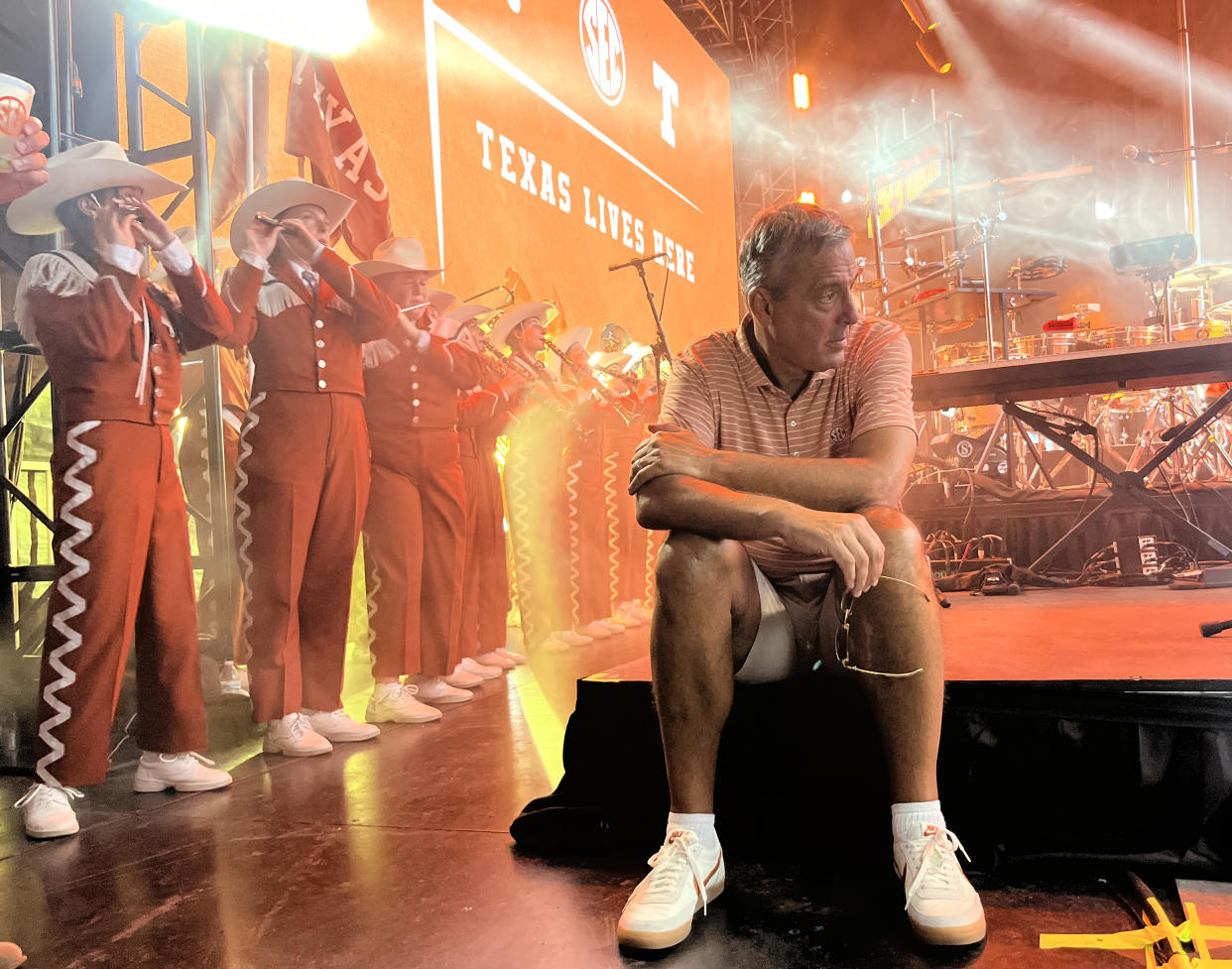
However, the SEC has asserted its dominance in many sports in a way that even Texas has not. A combined 10 different SEC programs have won football and baseball titles since Texas last won one of its own.
While Texas claimed a record-breaking 15 conference titles during its last season in the Big 12, one must wonder: Can the Longhorns replicate the success in the SEC? Is the school trading victories and championships for cash and prestige?
“The goal of Texas is to compete for national championships, and your student-athletes want to compete against the best,” Del Conte says. “Think about who gets recruited to SEC schools — the very best. It’s who you compete against. A rising tide floats all boats.”
The man at the middle of the move
Robin Ward Del Conte and Chris Del Conte will soon celebrate their 25th wedding anniversary. A math professor who still teaches part time at Rice — “Dr. Ward,” Chris calls her — Robin met her husband while each worked at Cal Poly. In fact, around the time of their wedding, he landed his first big job.
“He chalked fields and collected trash for Washington State,” Robin says, laughing.
More than two decades later, Chris, father to two adult daughters, is on his third stop as an athletic director (at TCU and Rice before this) and is in his seventh year presiding over one of the richest athletic departments in the country. He’s paid handsomely at $2.5 million annually to steer Texas into the uncertain waters of college athletics. It often seems like a dream to them both.
How the heck did this happen?
“One’s journey you can never predict,” Chris said. “Considering where I came from, you cannot predict this.”
He came from a tiny New Mexico town where his parents, Robert and Michele, raised him in an unusual but caring environment: They operated a group home for neglected children, serving more than 150 in foster care during Chris’ childhood.
Caring and kind enough, Robert Del Conte once stopped to help a stranded motorist on the roadside on an October night in 2000. The motorist knocked out Chris’ dad, cut his throat, robbed him and left him in a ditch.
Chris lost the man who had just months before given the toast at his wedding, the guy who served as his best man, who taught him most everything he knows.
Today, Chris speaks as if Robert Del Conte is still here. He uses present tense. He often embarks on long drives so he can, aloud in his truck, speak to his dad.
On Sunday, Chris Del Conte gestures toward the burnt orange-splashed festival unfurling around him and becomes emotional.
“I wish he could be here, but he did see me get my first job,” he says. “You’re hoping he’s watching. You never really know, but you want to believe he is.”
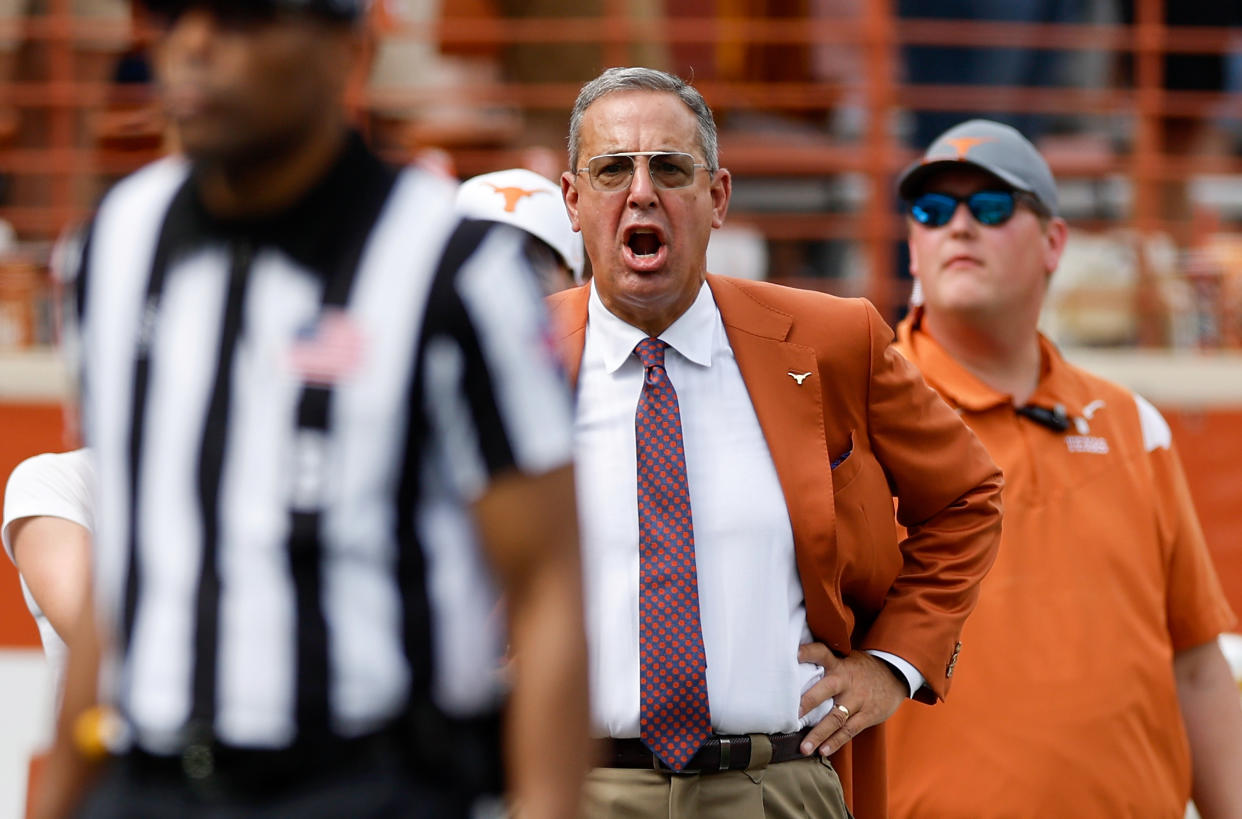
Sunday’s extravaganza is the culmination of a long journey, a three-year march to the SEC, Del Conte says. But it extends much further than that. For Del Conte, the impetus for a conference move started after the 2018 federal tax change that prevented school boosters from exempting donations tied to football premium-ticket sales. Texas generates $60 million annually in donations from boosters for premium seating — roughly one-quarter of its budget.
It became more difficult to get butts in seats. How does one enhance a home game schedule? Move conferences to join the likes of, say, Georgia and Florida, both of whom come to Darrell K Royal Stadium this fall.
In 2021, Del Conte presented the Texas board and president with “a menu,” he called it, on the landscape of college sports, including information on how the decrease in linear subscriptions could impact future broadcasting revenue and the Big 12’s impending TV deal. But perhaps the most important item concerned Texas’ home football schedule.
“Who you play matters now,” he says. “I have one rival game in Dallas. Who am I bringing to DKR? Those are the types of conversions that I lay out to my president and chairman of the board.”
That tax change combined with the Big 12’s stagnant television contract made the decision quite easy in the spring of 2021, when Del Conte and Hartzell phoned Sankey: “Would there be interest?” they asked.
Sankey knew that day would come. He recalls briefing his presidents as far back as 2016 about the potential of Texas searching for a new home. After all, the school came a whisker from moving to the Pac-12 in 2011. Finebaum recalls the SEC holding expansion conversations with the school around 1990, too.
“I remember the time 35 years ago when the SEC wanted Texas. It wasn’t ‘No.’ It was ‘Get out of my face!’” he says. “Texas always seemed to be in their own universe. Texas had to come to realize.”
Del Conte isn’t quick to refer to this conference move as the most significant of his career. At his last stop, as athletic director of TCU, he helped orchestrate the Horned Frogs’ shift into the Big 12 — a move that likely does not happen without, of all programs, Texas A&M. The Aggies’ departure from the Big 12 to the SEC left the spot for TCU.
Del Conte laughs now at that fact.
Thanks, Aggies.
Austin and the SEC: 'It’s going to be pandemonium'
High above the University of Texas campus, from within that iconic clock tower, all of downtown Austin is in sight.
It is a vibrant place, an economy bursting with expansion and enterprise, one of the country’s top booming cities at, now, nearly 1 million people. Giant cranes build new skyscrapers, bachelorette parties stream down streets, kayakers paddle along the Colorado River, guitar strums and savory barbecue fill the dry air.
It is electric here, an eclectic blend of Los Angeles, Dallas and Miami — a warm locale teeming with nightlife, a stellar food scene and water access. Grimey dive bars, swanky cocktail spots, historic barbecue joints, new age coffee shops, ritzy hotels and Michelin star eateries — this is Austin.
“This is an SEC town now,” says Martin, Del Conte’s deputy who orchestrated Sunday’s party. “This is an SEC school now.”
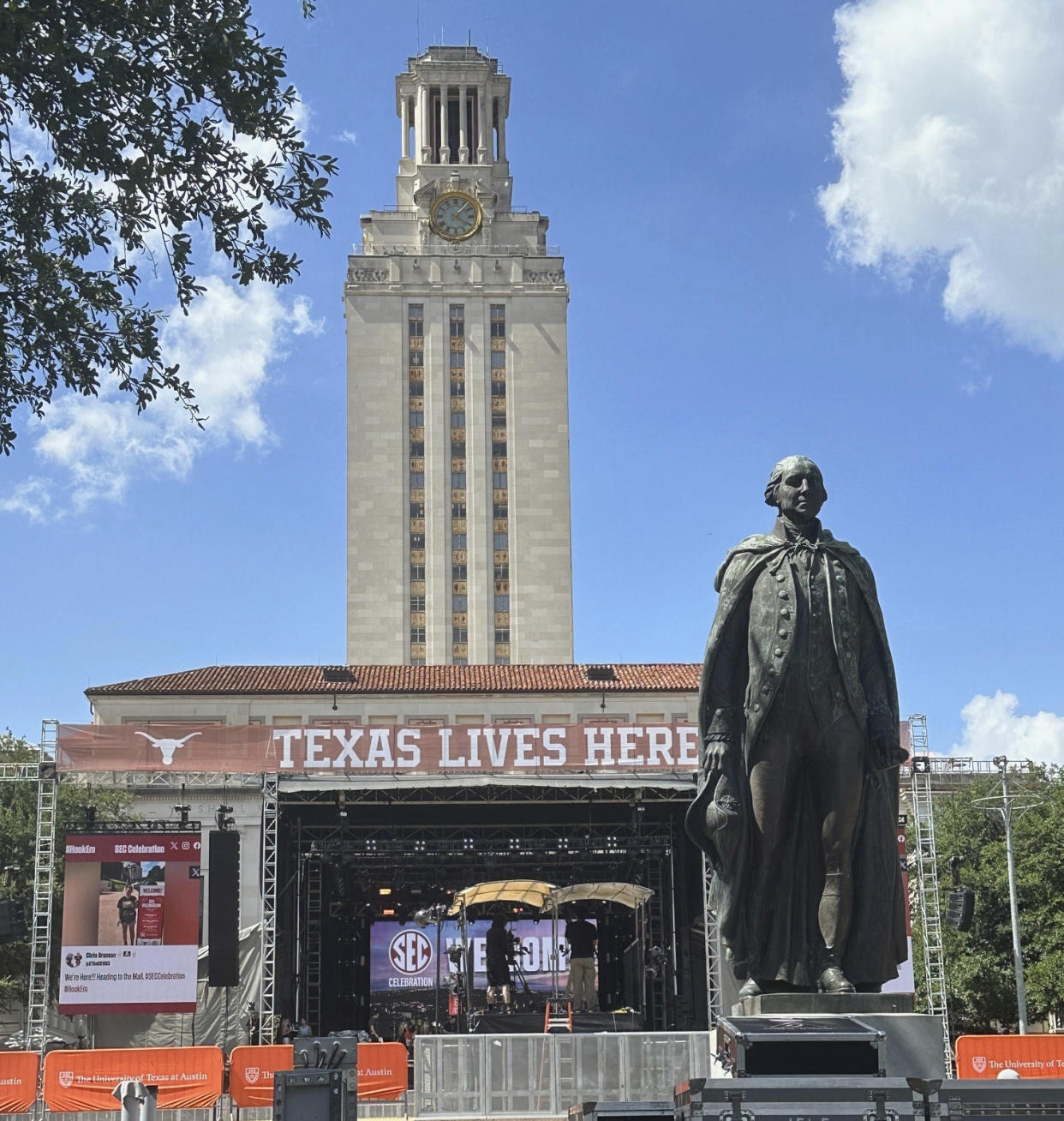
In the SEC, perhaps Nashville is the closest comparison to this place, but even that fails to capture it. Austin feels like the SEC’s new shiny thing — attractive, fascinating and dangerously addictive.
On the third weekend of October this fall, the city will host an SEC game between Texas and Georgia. A day later, an F1 race transpires here. “There’s one place on the face of the globe where you can have a high-level college football game and an F1 race,” Sankey said.
“It’s going to be pandemonium,” Del Conte smiled.
Austin — its lure and seduction — is another weapon for Texas in its foray into the country’s most powerful football league. Amid the evolving college sports landscape, the combination of city and school is a scary proposition for the rest of the sport.
Under the NCAA’s landmark settlement agreement, institutions will be permitted to distribute as much as $22 million to athletes annually as part of a capped revenue-sharing model. However, schools can circumvent this quasi-salary cap if their athletes earn third-party marketing and commercial opportunities — many of which are available in a city such as this.
Slap the “SEC” logo onto Texas material and Austin buildings and the behemoth becomes Goliath.
Is that a good thing? For the greater good of college football, the latest realignment isn’t necessarily a positive, some believe. “It’s going to make the rich get richer and the poor get poorer,” former Big 12 commissioner Bob Bowlsby said.
Those at Texas are fine with it.
“This is part of our evolutionary process as an athletics brand and university brand,” Martin said.
“There’s just been a separation, whether people like it or not, between the bigger schools with resources and the smaller ones,” Perrin said. “It makes sense for those that can congregate together to do it. I have people ask me all the time, ‘Why can’t we put the old Southwest Conference together?’ It doesn’t work that way.”
Speaking from his office, Hartzell is bullish on the future of Texas in the SEC. He’s also confident that the unstable landscape of college athletics will settle over the next two years if the settlement is finalized. He then hopes that within the decade there is federal intervention to provide a more long-term solution for college sports.
“I don’t think what it will look like in two years is what it will look like in five to 10 years,” Hartzell said. “I hope we can kind of rally people behind the idea of we should protect what’s best about it.”
In the meantime, there is a party to be had.
Down below, the crowd chants for Pitbull. Above them, in that wood-paneled office, Del Conte and Hartzell present Sankey with several gifts: a cowboy hat, boots and, of course, spurs.
The spurs, polished silver with a brown leather band, are inscribed with three letters: GAS.
“All gas,” Hartzell says.
Says Sankey: “There are no brakes in this league, buddy.”


